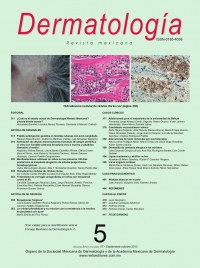Resumen
Resumen Antecedentes: el acné conglobata es una variante grave de acné con un origen multifactorial. La identificación de cinco familias con acné conglobata en la región oriental de Cuba aportó evidencias de la existencia de anticipación genética. Sin embargo, no se conocen su frecuencia, magnitud, ni los factores que la influyen o determinan. Objetivo: caracterizar el fenómeno de anticipación genética en familias cubanas con acné conglobata. Pacientes y método: estudio descriptivo de tipo transversal, realizado con 37 pacientes con acné conglobata. Se incluyeron en el estudio todos los enfermos con diagnóstico clínico de acné conglobata, en quienes fue posible precisar la edad de inicio de los primeros síntomas de la enfermedad. El diagnóstico se estableció con base en criterios clínicos. A partir de los 37 pacientes enfermos incluidos en el estudio, se conformaron 26 pares progenitordescendiente. Se recopiló información relativa a la familia a la que pertenece cada caso, al sexo y edad conceptiva del progenitor transmisor de la enfermedad y al sexo del descendiente enfermo. Resultados: hubo diferencias significativas para la edad de inicio de la enfermedad entre las generaciones (c2 = 12.8; p = 0.025). La anticipación tuvo una frecuencia de 100% y su magnitud varió entre 2 y 32 años, con media de 13.04 ± 8.85 años. Ni el sexo del progenitor transmisor de la enfermedad (p = 0.801), ni su edad conceptiva (p = 0.197), ni el sexo del descendiente (p = 0.20) influyeron de manera significativa en la anticipación genética. Conclusiones: se demostró la posible ocurrencia de anticipación genética en familias cubanas afectadas por acné conglobata, y que ésta no está influida por el sexo del progenitor transmisor de la enfermedad, la edad conceptiva o el sexo del descendiente. Palabras clave: acné conglobata, anticipación genética, edad de inicio, mutaciones dinámicas.
Palabras clave: acné conglobata, anticipación genética, edad de inicio, mutaciones dinámicas
Abstract
Abstract Background: Acne conglobata is a serious variant of acne that has a multifactorial etiology. The identification of five affected families in the eastern part of Cuba contributed evidences regarding the occurrence of genetic anticipation. However, its frequency, magnitude and modifying factors are unknown. Objective: To characterize the genetic anticipation in Cuban families affected by acne conglobata. Patients and method: A descriptive, cross-sectional study was carried out in a sample of 37 individuals with acne conglobata. All patients with clinical diagnosis of acne conglobata were included into the study, in which it was possible to specify the age at onset of first symptoms of the disease. Diagnosis was established based on clinical criteria. From the 37 patients included into the study, 26 pairs progenitor-descendant were conformed. It was compiled information related to family each case belongs to, sex and conceptive age of progenitor transmitter of the disease, as well as the sex of the ill descendant. Results: There were significant differences for the age at onset among generations (c2 = 12.86; p = 0.025). Anticipation had a frequency of 100%, and varied between 2 to 32 years with a mean of 13.04 ± 8.85 years. Nor the sex of the transmitting parent (p = 0.801), neither their conceptive age (p = 0.197) nor the sex of the offspring (p = 0.20) had a significant influence on genetic anticipation. Conclusions: It was proved the possible occurrence of genetic anticipation in Cuban families affected by acne conglobata, and it was not affected by the sex of the transmitting parent, neither their conceptive age nor the sex of the offspring. Key words: acne conglobata, genetic anticipation, age at onset, dynamic mutations.
Keywords: acne conglobata, genetic anticipation, age at onset, dynamic mutations

